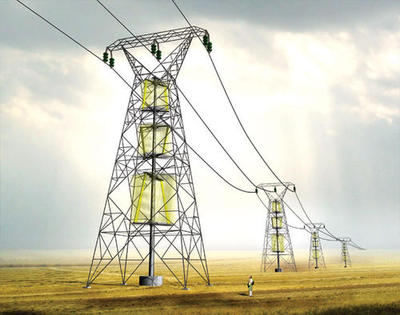energy
Building a House of Light and Wind
David Biello on the daunting physical logistics of scaling up green energy:
“It’s not just a matter of making the necessary equipment, it’s also a question of finding the space for it. A coal-fired power plant produces 100 to 1,000 watts per square meter, depending on the type of coal it burns and how that coal is mined. A typical photovoltaic system for turning sunlight into electricity produces just 9 watts per square meter, and wind provides only 1.5 watts per square meter.
The challenge is worse for smaller countries: the United Kingdom would have to cover its entire landmass with wind turbines to provide enough electricity for the current Briton’s average consumption — roughly 200 kilowatt-hours per day, according to MacKay, the Cambridge expert.”
I heard the design process was quite contentious at the FTC before settling on the familiar motif. The yellow EnergyGuide label has been used since the 1970’s for washing machines, refrigerators, and other large appliances sold in the US but never before for electronics. By making long term costs visible at the point of purchase, this humble bit of information design has saved an enormous amount of resources over the last 30+ years. It’s also a nice nudge to manufacturers who know the information will be public.

The Biggest Polluter

Each year Project Censored compiles a list of 25 urgent stories that are grossly underreported. But on this year’s chilling list, the scale of this one is just staggering:
“The US military is responsible for the most egregious and widespread pollution of the planet, yet this information and accompanying documentation goes almost entirely unreported. In spite of the evidence, the environmental impact of the US military goes largely unaddressed by environmental organizations and was not the focus of any discussions or proposed restrictions at the recent UN Climate Change Conference in Copenhagen. This impact includes uninhibited use of fossil fuels, massive creation of greenhouse gases, and extensive release of radioactive and chemical contaminants into the air, water, and soil.
The extensive global operations of the US military (wars, interventions, and secret operations on over one thousand bases around the world and six thousand facilities in the United States) are not counted against US greenhouse gas limits.…
As it stands, the Department of Defense is the largest polluter in the world, producing more hazardous waste than the five largest US chemical companies combined. Depleted uranium, petroleum, oil, pesticides, defoliant agents such as Agent Orange, and lead, along with vast amounts of radiation from weaponry produced, tested, and used, are just some of the pollutants with which the US military is contaminating the environment.”
The horror goes on and on and on.
And it makes me think a lot of sustainable designers may be fighting the wrong war.
 Roger K. Lewis in The Washington Post: “The Wall Street Journal got into the game recently with a report on concepts by four architectural firms that the newspaper asked to imagine the ‘Green House of the Future.’… Speculating about visionary green houses is tantalizing, but much greater benefits accrue at a larger scale.… Focusing on hypothetical designs of free-standing houses can even be a distraction.… No matter how green individual homes are, suburban sprawl is intrinsically anti-green. It generates infrastructure inefficiency; car dependency and rising fossil fuel demand; carbon-emitting, time-wasting road congestion; and, despite availability of inexpensive land at ever-greater distances from jobs, escalating development, construction and public service costs.… Transforming neighborhoods, buildings and infrastructure to accommodate new functions may be the best way for architects and the real estate industry to help create a greener planet.”
Roger K. Lewis in The Washington Post: “The Wall Street Journal got into the game recently with a report on concepts by four architectural firms that the newspaper asked to imagine the ‘Green House of the Future.’… Speculating about visionary green houses is tantalizing, but much greater benefits accrue at a larger scale.… Focusing on hypothetical designs of free-standing houses can even be a distraction.… No matter how green individual homes are, suburban sprawl is intrinsically anti-green. It generates infrastructure inefficiency; car dependency and rising fossil fuel demand; carbon-emitting, time-wasting road congestion; and, despite availability of inexpensive land at ever-greater distances from jobs, escalating development, construction and public service costs.… Transforming neighborhoods, buildings and infrastructure to accommodate new functions may be the best way for architects and the real estate industry to help create a greener planet.”

